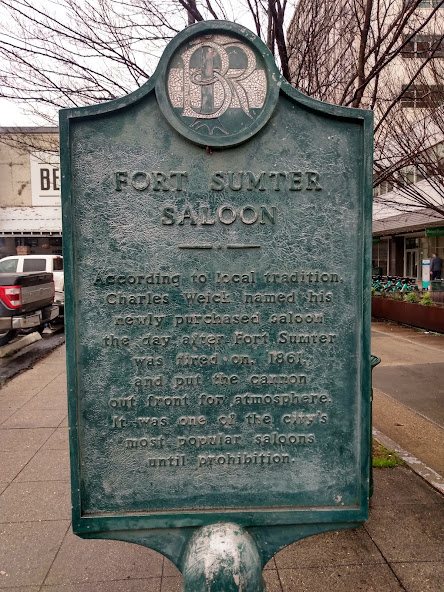If by chance you were curious about this strange object embedded in the sidewalk a nearby historical marker seems to provide a clue.
It reads: "FORT SUMPTER SALOON - According to local tradition, Charles Weick named his newly purchased saloon the day after Fort Sumter was fired on, 1861, and put the cannon out front for atmosphere. It was one of the city's most popular saloons until prohibition."
From that text you would assume that the mysterious object is the cannon that used to to be in front of Weick's old Fort Sumpter Saloon. For decades there have been several books written about the history of Baton Rouge and every one of them refer to this canon as the one that was once displayed in front of Weick's famous and historical watering hole and why wouldn't they - the sign says so after all.
Many people have been satisfied with that explanation except for the fact that it doesn't explain how the canon ended up embedded in the pavement.
That story is far more interesting and it proves that the historical marker isn't exactly accurate.
According to John Sykes the executive director of BREC's Magnolia Mound, who is working on a book about downtown Baton Rouge landmarks, the original location of Weick's saloon, where the cannon was displayed, was actually at Third and Main and not where this canon is located at Third and Laurel.
So that canon isn't this canon.
The truth is this is actually a British cannon from pre 1779 that was used to defend their fort in Baton Rouge. In 1779 that fort fell to Spanish forces and was renamed Fort San Carlos. In 1810 the fort was taken over by British and American settlers before the US Army eventually took it over.
Okay, that still doesn't explain how a pre revolutionary war cannon ended up embedded in a sidewalk.
In the 1850s, the cannons from the fort were sent to the John Hill Foundry on Third Street to be melted into sugar house machinery," Sykes said. "But the foundry sent the cannons back to the city to be imbedded into street corners to keep vehicles off the sidewalks. If you look at other old pictures of downtown Baton Rouge, you'll see some of these cannons."
In the 1960s the Department of Public works removed all of the canons except for this one at Third Street and Laurel. In fact this canon was saved in 1969 by local residents when it was supposed to be removed when the the streets were reconstructed.
Isn't it interesting that many of the people who work in downtown Baton Rouge walk past a historical artifact that dates from the days of the Revolutionary War everyday and they probably don't even notice it.
Check Out:
The Best Places To Visit in Louisiana 2023

















No comments:
Post a Comment